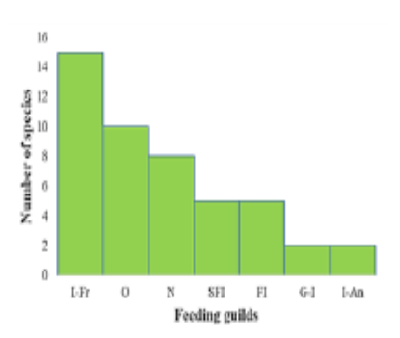


Indian Journal of Science and Technology
DOI: 10.17485/IJST/v16i46.2415
Year: 2023, Volume: 16, Issue: 46, Pages: 4300-4308
Original Article
Juan Felipe Melo1*, Santiago Vargas2, Mónica Andrea Castillo-Aguilar1
1Biology Research Group-(GRIB), Faculty of Sciences, Biology Program, El Bosque University, Bogotá, Colombia
2Research coordination BMC, Colombia
*Corresponding Author
Email: [email protected]
Received Date:22 September 2023, Accepted Date:28 October 2023, Published Date:11 December 2023
Objectives: The objective was to determine the composition and distribution of feeding guilds and bill volume of an assemblage of birds in four vegetation covers within the Terrapreta Private Natural Reserve. Methods: The vegetation covers were classified using Corine Land Cover method. Six sampling zones were defined, and three rounds were conducted between February and May 2023. Feeding guilds were identified according to diet, substrate, and foraging. Birds were captured with mist nets, bill measurements were taken, and volume was calculated. To evaluate guilds with vegetation cover, Marimekko, Chi-square and linear regression were performed, to establish the relation between bill volume and feeding guilds, a Boxplot plot and Wilcoxon rank-sum test were performed in the Rstudio program V. 4.3.1. Findings: 211 individuals in 6 order, 18 families, and 49 species, were captured and seven feeding guilds were identified: the most diverse (30.61%) and abundant (19.91%) group was Insectivore-Frugivore. In contrast, Granivore-Insectivore and Insectivore-Animalivore, had two species (4.08%) and 11 individuals (5.21%) each. The most abundant guild was found in a High Dense Terra Firme Forest (34.12%) with the highest specificity in bill volume (0.04 cm3 to 0.92 cm3) with total length values ranging between 7.7 cm and 20 cm. The relation between vegetation cover and the proportion of feeding guilds were significant (X2= 70.095, df = 18, p-value <0.05); feeding guilds and bill volume had statistically significant differences Wilcoxon rank-sum test (with a p<0.05). The impact on vegetation cover because of habitat transformation, especially on food resources, can be reflected in the guild structure, which can be interpreted as less ecosystem complexity, with the presence or absence of determined feeding guilds. Novelty: Functional traits, bill volume, and feeding guilds provide a tool to evaluate strategies for restoration process and contribute to management and conservation plans within protected natural reserves.
Keywords: Bill Volume, Birds, Feeding Guilds, Functional Traits, Guaviare, Vegetation Cover
© 2023 Melo et al. This is an open-access article distributed under the terms of the Creative Commons Attribution License, which permits unrestricted use, distribution, and reproduction in any medium, provided the original author and source are credited. Published By Indian Society for Education and Environment (iSee)
Subscribe now for latest articles and news.